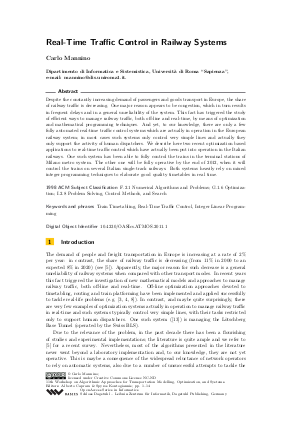Real-time traffic control in railway systems
Author Carlo Mannino
-
Part of:
Volume:
11th Workshop on Algorithmic Approaches for Transportation Modelling, Optimization, and Systems (ATMOS 2011)
Part of: Series: Open Access Series in Informatics (OASIcs)
Part of: Conference: Symposium on Algorithmic Approaches for Transportation Modelling, Optimization, and Systems (ATMOS) - License:
 Creative Commons Attribution-NonCommercial-NoDerivs 3.0 Unported license
Creative Commons Attribution-NonCommercial-NoDerivs 3.0 Unported license
- Publication Date: 2011-09-19
File

PDF
OASIcs.ATMOS.2011.1.pdf
- Filesize: 413 kB
- 14 pages
Document Identifiers
Subject Classification
Keywords
- Railway systems
- traffic control
Metrics
- Access Statistics
-
Total Accesses (updated on a weekly basis)
0Document
0Metadata
Abstract
Despite the constantly increasing demand of passengers and goods transport in Europe, the share of railway traffic is decreasing. One major reason appears to be congestion, which in turn results in frequent delays and in a general unreliability of the system. This fact has triggered the study of efficient ways to manage railway traffic, both off-line and real-time, by means of optimization and mathematical programming techniques. And yet, to our knowledge, there are only a few fully automated real-time traffic control systems which are actually in operation in the European railway system; in most cases such systems only control very simple lines and actually they only support the activity of human dispatchers. We describe here two recent optimization based applications to real-time traffic control which have actually been put into operation in the Italian railways. One such system has been able to fully control the trains in the terminal stations of Milano metro system. The other one will be fully operative by the end of 2012, when it will control the trains on several Italian single-track railways. Both systems heavily rely on mixed integer programming techniques to elaborate good quality timetables in real time.
Cite As Get BibTex
Carlo Mannino. Real-time traffic control in railway systems. In 11th Workshop on Algorithmic Approaches for Transportation Modelling, Optimization, and Systems. Open Access Series in Informatics (OASIcs), Volume 20, pp. 1-14, Schloss Dagstuhl – Leibniz-Zentrum für Informatik (2011)
https://doi.org/10.4230/OASIcs.ATMOS.2011.1
BibTex
@InProceedings{mannino:OASIcs.ATMOS.2011.1,
author = {Mannino, Carlo},
title = {{Real-time traffic control in railway systems}},
booktitle = {11th Workshop on Algorithmic Approaches for Transportation Modelling, Optimization, and Systems},
pages = {1--14},
series = {Open Access Series in Informatics (OASIcs)},
ISBN = {978-3-939897-33-0},
ISSN = {2190-6807},
year = {2011},
volume = {20},
editor = {Caprara, Alberto and Kontogiannis, Spyros},
publisher = {Schloss Dagstuhl -- Leibniz-Zentrum f{\"u}r Informatik},
address = {Dagstuhl, Germany},
URL = {https://drops.dagstuhl.de/entities/document/10.4230/OASIcs.ATMOS.2011.1},
URN = {urn:nbn:de:0030-drops-32623},
doi = {10.4230/OASIcs.ATMOS.2011.1},
annote = {Keywords: Railway systems, traffic control}
}
